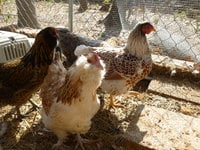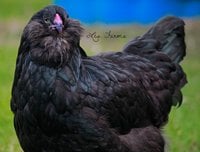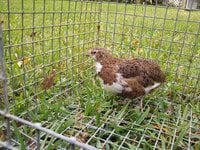Big, slow, and pretty, but not as stupid or shy as described. Our family has mixed feeling about this particular bird.
Social Features: (4/5)
Our hen is not pushy but not a pushover either. She is a middle of the road hen, dominating over our Ameraucanas but submitting to our Australorps.
She is not aggressive in the least and has a gentler peck when hand fed than our Australorps (who will eat your hand too). Of all our hens, she is the slowest and easiest to catch, making her a better choice for holding, though she doesn't enjoy it. However, unlike our other birds, she's a little less prone to kicking to get away. She's big too, so much more cuddly.
She's a curious bird, but a bit on the skittish side (having flown the coop out of a false sense of danger).
Egg Laying Features: (1/5)
Hands down our worst layer. She gets a single point for have large to jumbo eggs, but we rarely get to see them. She started laying very late (even after our cochin) and is a strange kind of broody. She will often rush to the nest box when we are collecting eggs or just sit in empty nest boxes. But she doesn't stay there with any consistency making her a poor choice for a brood mother. With her lazy style of brooding, she can't be broken of it and lays an egg once a week maybe. We don't know what to do about this bird.
Climate Features: (3/5)
More cold hardy than heat hardy, she does decently well in Utah. She had no problems with the cold temperatures and her shorter leg feathers meant less snowballs. However, in the summer, she pants all the time and is pretty unhappy (unless given grass to eat). Her large beard is prone to getting horrendously muddy and the feathers can curl back into her eyes.
She hasn't been sick or succumbed to heatstroke or frostbite, but there are definitely better birds for all climate weather.
She's a decent forager and given the chance she will graze on grass from dusk to dawn. This helps keep her feed intake down for her size, but she still eats quite a bit.
Afterthought: Probably a better table bird than a layer, sadly enough.
Social Features: (4/5)
Our hen is not pushy but not a pushover either. She is a middle of the road hen, dominating over our Ameraucanas but submitting to our Australorps.
She is not aggressive in the least and has a gentler peck when hand fed than our Australorps (who will eat your hand too). Of all our hens, she is the slowest and easiest to catch, making her a better choice for holding, though she doesn't enjoy it. However, unlike our other birds, she's a little less prone to kicking to get away. She's big too, so much more cuddly.
She's a curious bird, but a bit on the skittish side (having flown the coop out of a false sense of danger).
Egg Laying Features: (1/5)
Hands down our worst layer. She gets a single point for have large to jumbo eggs, but we rarely get to see them. She started laying very late (even after our cochin) and is a strange kind of broody. She will often rush to the nest box when we are collecting eggs or just sit in empty nest boxes. But she doesn't stay there with any consistency making her a poor choice for a brood mother. With her lazy style of brooding, she can't be broken of it and lays an egg once a week maybe. We don't know what to do about this bird.
Climate Features: (3/5)
More cold hardy than heat hardy, she does decently well in Utah. She had no problems with the cold temperatures and her shorter leg feathers meant less snowballs. However, in the summer, she pants all the time and is pretty unhappy (unless given grass to eat). Her large beard is prone to getting horrendously muddy and the feathers can curl back into her eyes.
She hasn't been sick or succumbed to heatstroke or frostbite, but there are definitely better birds for all climate weather.
She's a decent forager and given the chance she will graze on grass from dusk to dawn. This helps keep her feed intake down for her size, but she still eats quite a bit.
Afterthought: Probably a better table bird than a layer, sadly enough.




